
9 minute read
Noreen Riordan
from Upstate Gardeners' Journal November-December 2020
by JFM Publishing—(585) magazine / (585) Kids / Upstate Gardeners' Journal
Specialist in many things: Artist, arborist, and horticulturist Noreen Riordan
Compiled and edited by Michelle Sutton; photos courtesy Noreen Riordan except where noted
Advertisement
Noreen Riordan lives in Henrietta and serves a greater Rochester territory as an arborist representative for Bartlett Tree Experts. Her territory includes Greece, Henrietta, Irondequoit, Webster, and some of Penfield and Brighton. Noreen is an ISA-Certified Arborist and Certified Nursery and Landscape Professional who has extensive experience with, among other things, Emerald Ash Borer. Noreen’s love of plants is informed by being an artist and her art is informed by her love of plants; she has a BFA in art and photography from Syracuse University. Here’s Noreen in her own words.
ABOVE: Noreen calls this “a treasured place: Rocky Mountain, Inlet, NY. I’ve been climbing this mountain with family and friends for 50 years.” Photo by Deb Putman
When I got my first house, I really went bananas for gardening and haven’t looked back. I find gardening so gratifying in the way it allows me to bring in birds, bees, and other wildlife with the habitats I create. I’m grateful to my mom and grandmother for passing down the gardening gene! I’m especially into birds, and as I worked for nurseries and my own landscaping company for many years, I got more interested in trees and how miraculous and important they are. If you’re into birds, you’re likely to be into trees.
I’m happy to say that both of my daughters, Molly and Emily, have gotten into birdwatching. We all have feeders, compare who visits them, and get jealous of each other’s birds. Eastern bluebirds are my favorite, but it’s my older daughter Molly who gets frequented by them. Meanwhile, I get all the chickadees, and my daughters are envious of that. It’s something fun to bond over.
I had a home-based business retouching photos when my kids were little and did that while I raised them. When digital photography came into dominance, I made the career change to nursery and landscaping jobs. It was very exciting and a lot more physically and intellectually demanding than I thought—and so vast! Soils, light needs, native vs. exotic, spacing—there was a lot to learn. Around 2000, I achieved the Certified Nursery and Landscape Professional (CNLP) credential, my ISA Arborist Certification, and also became a NYSDEC Certified Pesticide Applicator.
Beginning in 2009, I became intensely focused on Emerald Ash Borer (EAB) because it posed such a huge threat to our region’s many ash trees. I served on the Monroe County Emerald Ash Borer Task Force and did presentations to educate the public. Through my work, I did injections in ash trees; I became skillful in identifying which trees could be saved and prosper, and which ones weren’t worth treating—knowledge I use quite a lot to this day. It is gratifying to see ash trees that I injected thriving, beautiful, and providing all the ecosystem services they are capable of.
That said, there are a lot of dead green ash (Fraxinus pensylvanica) trees near where I live now in Henrietta, which can be depressing. I worry a bit about the mature standing dead trees (snags) posing hazards to people. Woodpeckers do love the snags for nesting and food, but, over time, the EAB-decimated ash trees don’t stand up well. That said, where snags don’t pose a hazard to people or property, such as in homeowner woodlots, I think it’s cool when people keep them for bird habitat.
It’s gratifying to realize at this point in my life that I know a lot about a lot of things and at the same time, I’m still learning. Through my job as Arborist Representative with Bartlett, I’m immersed in Plant Health Care (PHC) (see sidebar). If a client calls because they are having a disease or insect pest on a treasured plant, I have my knowledge base to look at everything and offer suggestions. But I also have Bartlett’s Diagnostic Lab at my disposal, which has been phenomenal in putting PHC into practice.
Through PHC, I’m learning about the new diseases and insect pests and what treatments are available. Integrated
WHAT IS PLANT HEALTH CARE?
From the International Society of Arboriculture:
The objective of PHC is to maintain or improve the landscape’s appearance, vitality, and—in the case of trees— safety, using the most cost-effective and environmentally sensitive practices and treatments available. Plant Health Care involves routine monitoring, preventive treatment, and a strong working relationship between the arborist and the property owner.
Pest Management (IPM) is a critical component of PHC; IPM is all about proper timing for treatment. From experience with ash trees, I know that if an ash tree looks a certain way, I can tell it’s not going to respond to treatment so I’m honest with homeowners about that. But with other plants, I will frequently take a soil and foliage sample to send to Bartlett’s diagnostic lab at its Tree Research Laboratories in Charlotte, North Carolina to get highly detailed information about what nutrients and pathogens are in the soil and in the leaf sample.
Why a leaf sample? The analysis of the foliage sample shows what soil components the tree is actually taking up through its vascular system. Sometimes a nutrient is present in the soil but is not available for uptake because of limiting chemical interactions. An example of this is manganese-deficiency chlorosis on red maples, which makes the leaves look yellowed. It may be that there’s not enough manganese in the soil, which means the addition of a manganese chelate is warranted, or there may be sufficient manganese in the soil, but the Bartlett lab may recommend we add sulfur to chemically free up the manganese to make it available for uptake.
I’ve been flooding Bartlett’s diagnostic lab with samples! Reading those diagnostic lab reports is a great education and of course, I pass the reports along to my clients, along with my recommendations. Among many things, I’ve learned that lacebug in Japanese andromeda (Pieris japonica) shrubs is almost a given, but that it can be treated. I’ve learned about how vulnerable boxwoods in our region are to spider mites, leaf miners, and psyllids— so much so that several different appropriately-timed treatments are necessary if the plants are to thrive. I can help the homeowner decide if that’s the course they’d like to pursue.
In 2020, our region wrestled with a huge infestation of gypsy moth (see photos), with Irondequoit as the epicenter and oak trees most affected. Injections for gypsy moth kill all caterpillars, not just the gypsy moth larvae. The bird-loving part of me thinks about how chickadees are so closely connected to oak trees, which have 249 types of
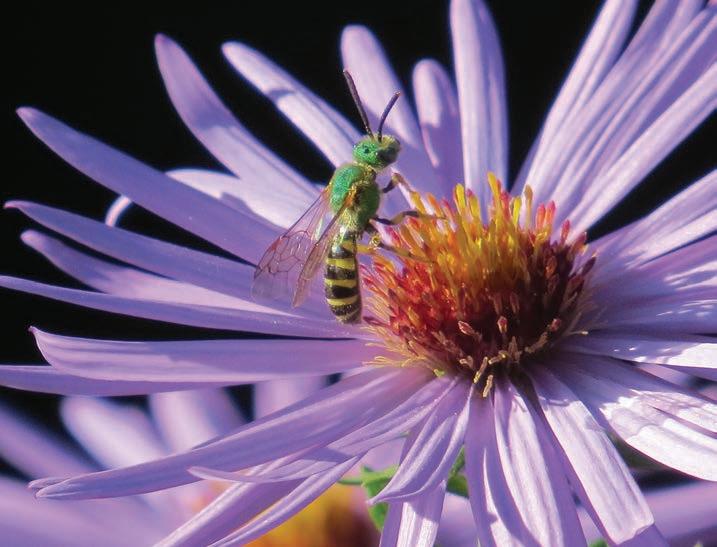

caterpillars that feed this bird species, and how a chickadee needs 6000 caterpillars just to feed their first clutch of babies. I think about how valuable that caterpillar food source is.
However, if the trees are decimated by gypsy moth year after year and the trees die, they’re not much good to the chickadees for nesting, cover, and other food sources, and they no longer provide shade and beauty for humans. Whole forest regions can be cleared by gypsy moths, which doesn’t serve anyone. So it’s a complicated line to walk. Also, I’m sympathetic to homeowners who have oak trees above their decks and are experiencing the unpleasantness of gypsy moth frass (excrement) falling on their patio and outdoor dining furniture.
My experience with EAB comes to bear with the trees infested with gypsy moth. For instance, I had a client in Irondequoit who had 30 oak trees at risk, but she couldn’t
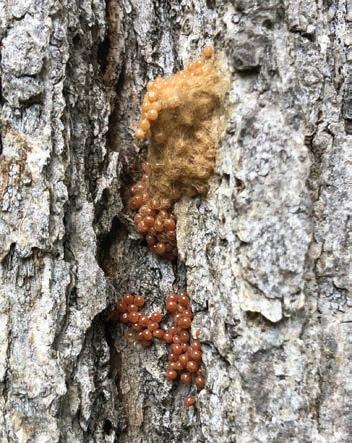
TOP: Noreen has a BFA in Art and Photography from Syracuse University.
BOTTOM LEFT:
Gypsy moth mama covering eggs with hairs
BOTTOM RIGHT: Gypsy moth eggs
The most important accomplishment of my life is helping raise two intelligent, independent, empathetic women. My daughters are best friends. One is a school psychologist and the other is an immigration attorney. Both believe passionately in equality and civil rights. We attended several marches and protests together pre-COVID, and they continue to do so in their respective cities.
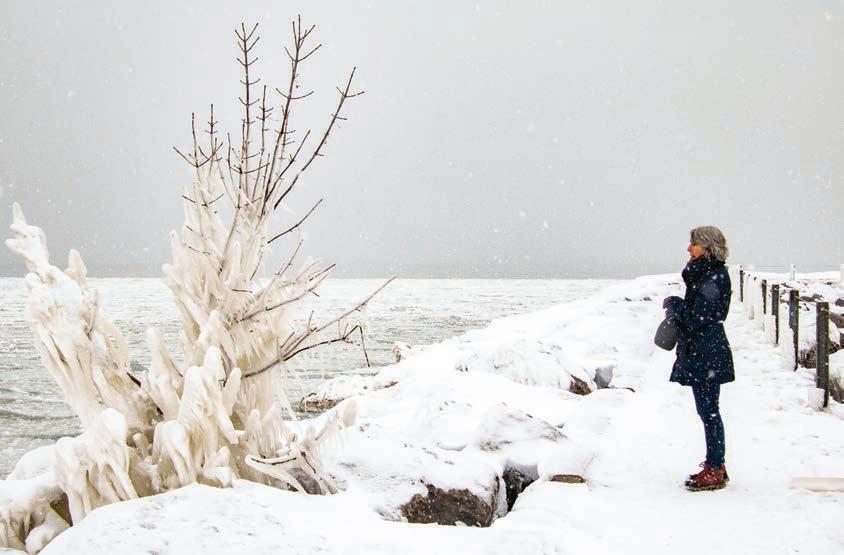
—Noreen Riordan
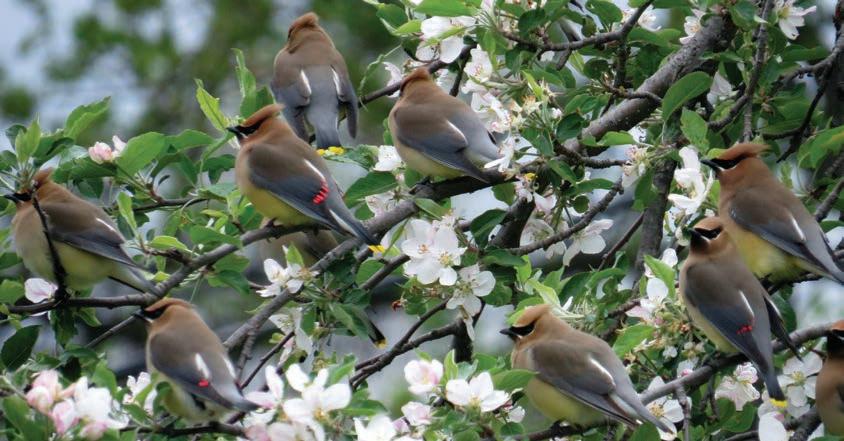
TOP: Noreen at Charlotte Pier on Lake Ontario last winter. Photo by Deb Putman
BOTTOM: Cedar waxwings afford to treat them all. I helped her prioritize which ones to keep based on those that had the best possibility of recovery and a long healthy life. I enjoy this work greatly, and I love getting to know the clients and getting to visit their unique properties. I’ve met so many nice people, many of whom are also into birds and are concerned about trees. The social aspect of my job is terrific.
On my property I’m enjoying taking out invasive plants like buckthorn and plants like privet that provide meager ecosystem benefits, and I’m replacing them with native plants that provide maximum services to wildlife. I put a rain garden in front of the house where there’s a swale— that’s doing really well. My yard is fenced in, high enough to deter the deer most of the time. I’ve left a snag tree up where it’s not a hazard, and that’s been home to tons of woodpeckers. I’m growing vegetables all over the place.
My favorite movie is Moana, because it’s about a strong female character who is concerned for the environment and for her people. I find very poignant the lyric, “See the line where the sky meets the sea? It calls me.” I love the ocean, the beach, the Adirondacks. We are stewards of this beautiful planet and we need to do all we can to help the earth and one another, whether that be eating less meat, getting solar panels, reducing waste, being kind, or wearing a mask!
Michelle Sutton is a horticulturist, editor, and writer.
NOREEN RECOMMENDS
By Doug Tallamy:
Bringing Nature Home: How You Can Sustain Wildlife with
Native Plants and
Nature’s Best Hope: A New Approach to Conservation
That Starts in Your Yard
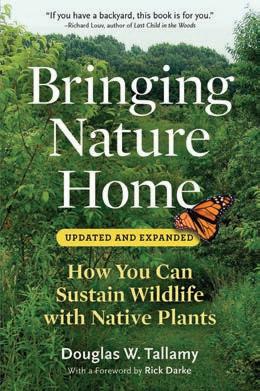
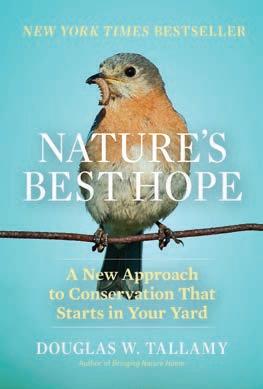
By Sy Montgomery:
The Soul of an Octopus: A Surprising Exploration in the
Wonder of Consciousness
By Richard Powers: The Overstory


Your favorite gardening magazine is online.

Check us out at UpstateGardenersJournal.com.





